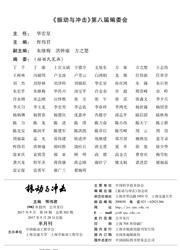

 中文摘要:
中文摘要:
对飞机舱室结构进行薄壁-腔体振声耦合特性的研究是进行舱室噪声控制和声学设计的关键问题;基于波动声学的数值仿真方法是舱室场景中振声耦合分析常用的方法,但由于受刚度矩阵失真影响,在中频段普遍存在高色散误差。针对此问题,以降低振声耦合系统的刚度矩阵失真为目标,发展了一种具有低色散误差的无网格仿真模型;首先推导了外力及声源混合激励源下的振声耦合系统;然后发展了一种基于无网格支撑域的声压梯度光滑技术,可降低耦合系统的刚度;最后将低刚度的声压梯度光滑技术与高刚度的经典无网格法进行结合,提出一种在中低频段内自适应的刚度矩阵重组技术,最终得到低色散无网格仿真模型。矩形封闭空间及实际舱段结构的算例对比均显示低色散无网格仿真模型能够使离散系统刚度更接近连续系统的刚度,从而在较宽的中低频段内使数值解更接近真实解。
 英文摘要:
英文摘要:
Analyzing the acoustic-structural coupling in airplane cabins is an important problem in the noise control and acoustic design. The wave-based methods,such as finite element method and classical meshless method,are commonly used in simulations of the acoustic-structural coupling in cabins. However,these methods usually suffer from the dispersion,which reduces the accuracy in mid-frequency range. Aiming at the problem,a low dispersion meshless model was developed,which is capable of reducing the distortion of the stiffness matrix. Firstly,a model for the acousticstructural coupling under hybrid exciting sources was derived. Then,a smoothing technique for sound pressure gradients was developed based on the supporting domain of the meshless method. The technique can reduce the matrix stiffness of the coupling model. Lastly,a new stiffness matrix was reconstructed by combining the ones obtained by the classical meshless method and smoothing technique. The low dispersion meshless model has been used to simulate the acousticstructural coupling of a rectangular enclosure and a practical cabin structure. The results were compared with those obtained by the finite element method,classical method and measurement. The comparisons demonstrate that the low dispersion meshless model has higher accuracy for simulating the system stiffness and gives closer results to real solutions in mid-frequency ranges.
 同期刊论文项目
同期刊论文项目
 同项目期刊论文
同项目期刊论文
 期刊信息
期刊信息
